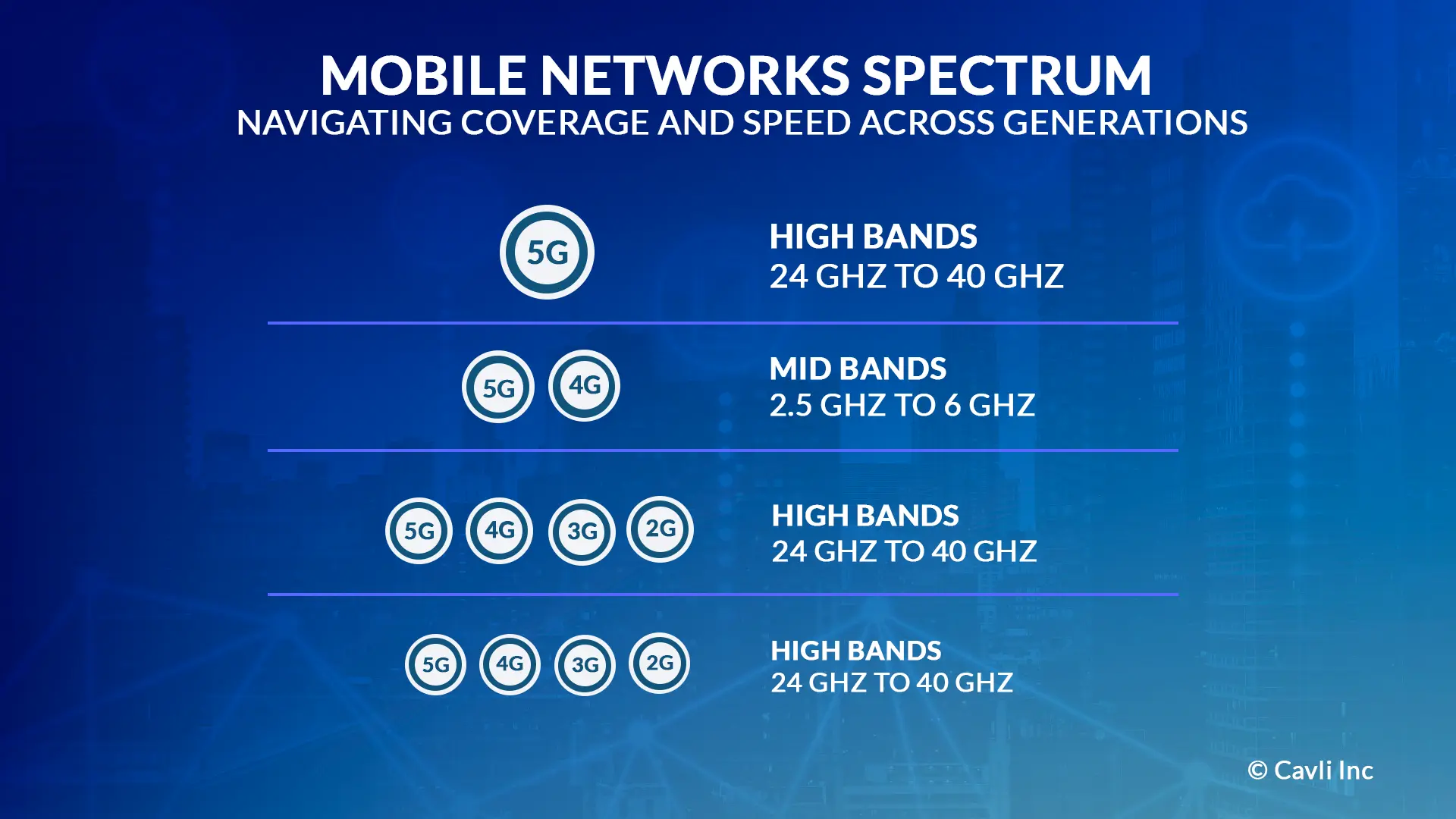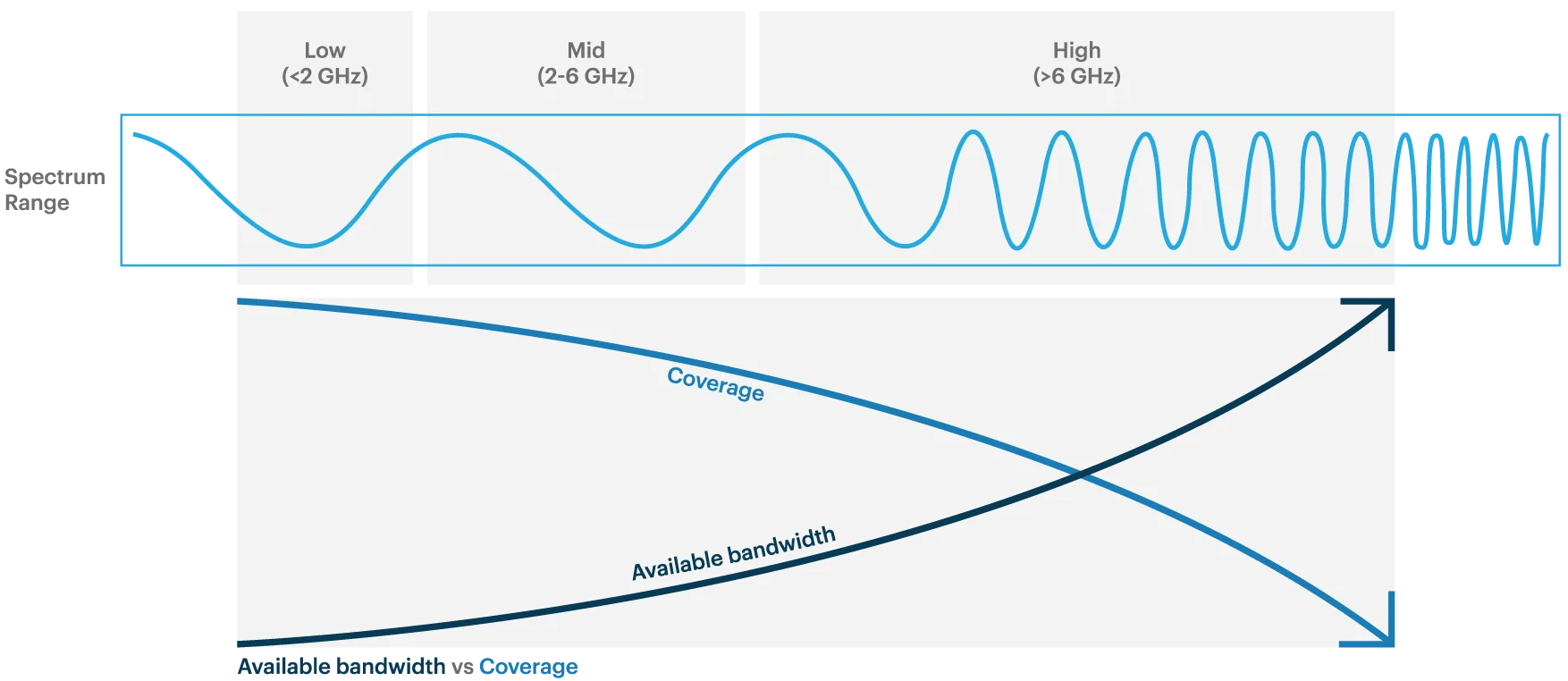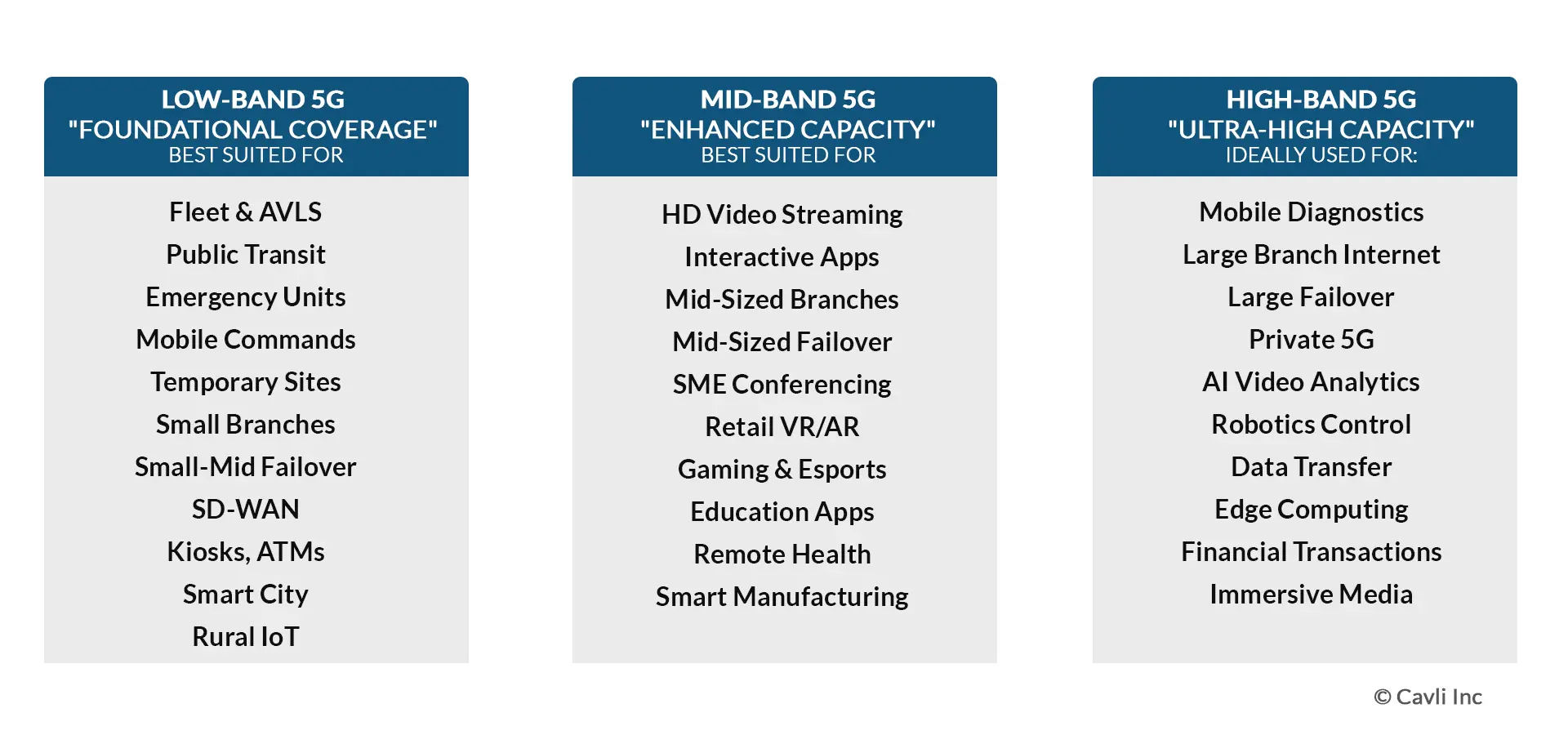Tarun Thomas George
Co-founder, Chief Operating Officer
Cavli Wireless
What is 5G?
5G (Fifth Generation) is the latest wireless communication technology, designed to deliver faster data speeds, lower latency, and more reliable connections compared to its predecessors. It enables ultra-fast internet, supports IoT growth, and enhances mobile broadband services. 5G's advanced features are pivotal for emerging technologies such as autonomous vehicles, smart cities, and augmented reality, offering improved network efficiency and massive device connectivity.
Over the last few years, communication technology standards have evolved considerably. Since the release of the first generation (1G) technology in the 1980s, the flywheel has ensured the release of newer and improved wireless mobile telecommunication protocols roughly every ten years. The first generation of mobile networks (1G), with a data speed of 2.4 kbps, was all about voice. The second (2G), with a data speed of 64 Kbps and based on GSM gave room for texting along with voice, which was a revolutionary upgrade. An avenue for non-intrusive non-critical information exchange was a very welcome addition. The third (3G), with a data speed of 144 kbps-2 Mbps, was about voice, texting, and data and truly opened up the first generation of smartphones to the world and the ensuing fight for supremacy between the biggest known names in the consumer smartphone segment, namely the Samsungs, Apples, Motorolas. The fourth (4G) was everything in 3G but faster. Subsequent generations of wireless technologies have become faster and improved with new features.
All of them, as stated above, have different speeds and features that improve on the previous generation. Today, most wireless carriers support both 4G and 3G technology. The next-generation communication technology, which is 5G, is more than just the data speed. Industry experts predict it can do wonders in the Internet of Things sector. 5G and IoT are seen as complementary technologies driving innovation in smart cities, autonomous vehicles, and healthcare solutions. 5G is touted as the next elixir after the advent of the internet & the world wide web, set to create tectonic shifts across Industries and business processes.
5G technology is not limited to just speed; it promises ultra-low latency, higher capacity, and network slicing capabilities. These features make 5G for IoT particularly promising, enabling seamless connectivity and real-time data processing for a myriad of connected devices. The potential of 5G & IoT is immense, poised to revolutionize various industries and drive significant advancements in business processes.
Entering the 5G era, as of 2019, there were an estimated 22 billion connected devices on the planet, with almost 9 billion of them being smartphones connected on cellular. The rest are the countless million devices, machines, and equipment connected to the internet. The number of cellular-connected devices is expected to surge from around 800 million worldwide right now to over 4 billion in the next 4 to 5 years, and one definite driver for that accelerated adoption will be the proliferation of 5G.
5G, the latest in telecommunications, offers substantially faster speeds, lower latency, and greater connectivity than previous generations. It enhances user experiences with rapid downloads and uploads, enabling high-quality streaming, gaming, and seamless communication.
5G's capabilities are crucial for the Internet of Things (IoT), supporting a vast network of devices for smarter cities, healthcare, agricultural, and manufacturing through improved device-server communication. This technology also introduces enhanced reliability and capacity, fostering innovations in autonomous vehicles, augmented reality, and remote healthcare, and reshaping our interactions with technology.
5G NR (New Radio) is central to achieving these advancements, supporting various frequency bands to cater to different coverage and capacity needs, from urban to rural areas. Meanwhile, 5G RedCap (Reduced Capability) makes 5G accessible for simpler devices like wearables and IoT sensors, offering cost-effective connectivity and promoting a more inclusive digital ecosystem. Together, 5G NR and RedCap are essential for the wide-ranging impact of 5G, ensuring it meets diverse needs while driving efficiency and opening up new possibilities across multiple sectors.
The prevalent cellular IoT technologies offer low-cost, low-power solutions with broad indoor and outdoor coverage, ensuring secure connectivity and easy deployment across diverse network topologies. 5G, standardized by the Third Generation Partnership Project (3GPP), integrates existing LPWAN protocols like NB-IoT, ensuring a smooth transition for product makers and customers. The introduction of 5G technology revolutionizes the IoT landscape with its unparalleled speed, ultra-low latency, and expansive bandwidth. This facilitates seamless communication among IoT devices, enabling real-time data transmission and processing for enhanced efficiency and productivity.
With speeds up to several gigabits per second and latency reduced to 30 milliseconds, 5G empowers precise tasks such as remote surgery and predictive maintenance across various industries. Additionally, the integration of 5G connectivity fosters innovation and scalability within businesses, effectively supporting a multitude of IoT devices while maintaining optimal performance. This scalability not only facilitates informed decision-making but also enhances operational efficiency within an interconnected environment, thereby propelling organizations towards unparalleled success in the digital era.

There are three versions of 5G being built, and even though they differ in terms of network architecture, they will eventually work together. There are four major U.S wireless companies developing plans on how to build out 5G to their customer bases, these are namely - AT&T, T-Mobile, Verizon, and Sprint. Their strategies depend on current wireless spectrum holdings. Below are the three versions of 5G:
Low band is the closest 5G spectrum to 4G LTE with operating frequencies closer to TV and radio stations. It has a speed that is 20 percent faster than 4G LTE networks. The biggest advantage over the other 5G types, being the ability of the signal to travel longer distances.
This is an advancement over Low-band 5G, with a speed 6x faster than LTE networks. Mid-band is quite synonymous with the sub-6 GHz spectrum. While mid-band is wider than low-band and can transport more data, it can’t travel as far as Low-band. This issue however gets bigger with mmWave high-band 5G as described below.
These extremely low latency networks have speeds that are 10x faster than LTE networks. The catch being the requirement for repeaters is very high for mmWave transmission as it is mostly line of sight transmission. mmWave, the spectrum between 30 GHz - 200 GHz has the ability to carry great amounts of data at extremely high speeds, contributing a lot to the huge attention around 5G technology. Almost all of the innovative use cases doing the rounds like precision surgery in healthcare is riding on mmWave technology

With IoT-enabled devices in mind, 5G technology connects devices at relatively higher speeds and minimizes lag. This makes 5G the most sought-after wireless technology when it comes to creating an excellent user experience regardless of what device, service, or application you are dealing with. Below are the top advantages of the release of 5G networks in a fast-paced world.
The success of any IoT device is directly linked to its performance. Quick and easy device communication is key to making quick and prompt decisions. 5G technology is expected to offer faster speed than current LTE networks. For example, when it comes to smart home devices, this increase in data transfer speed helps to reduce the lag and improve the overall speed at which connected devices send and receive data and notifications.
Every new generation of the mobile network is built to deliver faster speeds when compared to their previous ones.
| Mobile Network | Average Speed | Peak Speed |
|---|---|---|
| 2G | 0.1 Mbps | 0.3 Mbps |
| 3G | 3 Mbps | 7.2 Mbps |
| 3G (HSPA+) | 6 Mbps | 42 Mbps |
| 4G LTE | 20 Mbps | 150 Mbps |
| 4G LTE Advanced | 42 Mbps | 1 Gbps |
| 5G | 500-700 Mbps | 10 or 20 Gbps |
Note: 5G speed estimates gathered based on current speed tests available on Verizon’s 5G Ultra Wideband network. Carriers claim 5G speeds are 10 or 20 times faster than 4G LTE.
[Source: letstalk.com]
The 5G network's high-speed connectivity, low latency, and more excellent coverage will be essential for IoT. To take advantage of these improvements, manufacturers must first invest in building 5G-compatible devices.

Leveraging a 5G IoT network, individuals can effortlessly navigate parking spaces without the hassle of manually searching for spots. Through seamless connectivity, cars can be parked remotely or summoned directly to the desired location, enhancing convenience and efficiency.
Farmers can harness the power of IoT networks to monitor crops and livestock with unprecedented precision. Remote monitoring and control of agricultural equipment enable efficient management of farming operations, optimizing yields and resource utilization.
With the low latency capabilities of 5G, healthcare professionals can conduct remote surgeries and medical procedures with enhanced precision and real-time responsiveness. This technology breakthrough facilitates access to healthcare services in remote areas and improves patient outcomes.
The low latency offered by 5G networks enhances entertainment experiences, allowing users to stream high-definition content and play AAA games without the need for extensive downloads or installations. This seamless connectivity transforms the way we consume media and enjoy recreational activities.
IoT-enabled devices empower individuals to monitor and manage their homes remotely, even while they are away on vacation. From controlling smart thermostats and lighting systems to monitoring security cameras and robot vacuum cleaners, 5G IoT networks provide unparalleled convenience and peace of mind.
The top three industries that will benefit the most with 5G technology in IoT are:



As we edge closer to a fully connected world, the convergence of 5G and the Internet of Things (IoT) is set to redefine urban living. Imagine strolling through smart cities where traffic flows smoothly without congestion, public services are automated and efficient, and security systems are so advanced that they preemptively maintain urban safety. This isn't a scene from a futuristic movie; it's the imminent reality made possible by 5G and IoT technologies.
In smart cities like Barcelona and Singapore, IoT devices are already optimizing traffic management through intelligent traffic lights and public transit systems to reduce wait times and improve flow. However, with 5G's ultra-reliable low latency communication (URLLC), the impact on traffic management escalates to new heights. Real-time data from thousands of sensors can be processed swiftly, allowing cities to dynamically adjust traffic signals to cut down bottlenecks during peak hours. This results in less congestion and more efficient urban transport.
5G technology enhances urban safety significantly. It supports a vast network of devices simultaneously, enabling cities to deploy IoT sensors extensively across various infrastructures. For instance, IoT-equipped buildings can detect structural weaknesses and alert authorities before any visible signs of damage emerge, thus preventing potential disasters. Additionally, IoT devices monitor urban areas for unusual activities, providing real-time updates to law enforcement and ensuring comprehensive public safety.
Utility management in smart cities is another sector ripe for transformation. IoT sensors in water management can track usage and leakage in real-time, enabling immediate repairs and significantly reducing wastage. Similarly, IoT applications in energy management optimize power distribution based on real-time demand analysis, enhancing energy efficiency and reducing operational costs.
As the world grapples with climate change and environmental sustainability, the role of technology, especially 5G and the Internet of Things (IoT), in promoting eco-friendly practices has become crucial. The integration of these technologies in both urban and rural settings is not just about enhancing efficiency but also about reducing the ecological footprint of our communities.
One of the standout features of IoT devices enabled by 5G technology is their ability to drastically improve energy efficiency. In smart cities, IoT systems can manage everything from reducing energy usage in homes to controlling street lighting based on real-time data. For instance, smart lighting systems can adjust the brightness based on the presence of people, thereby conserving electricity. Similarly, smart grids can optimize power distribution, reducing waste and promoting the use of renewable energy sources.
IoT technologies foster more sustainable resource management. For example, smart agriculture systems use IoT sensors to monitor soil moisture levels and optimize water usage, significantly cutting down water consumption and minimizing environmental strain. These systems ensure that water and fertilizers are used efficiently, promoting sustainable agricultural practices that benefit the environment.
5G can play a pivotal role in improving air quality. With its enhanced connectivity, 5G supports the deployment of air quality monitoring systems that provide accurate, real-time data on pollution levels. This information can help regulate industrial emissions and traffic congestion, leading to a cleaner and healthier environment.
The evolution from 2G, 3G, and 4G to 5G technology marks a pivotal shift in both consumer and industrial landscapes. As we advance, we are poised to see large-scale automation across utility services, automotive industries, and numerous smart city applications.
Connected homes, healthcare wearables, and smartwatches represent the forefront of this technological wave, set to expand significantly due to the enhanced performance and high-speed capabilities of 5G. The global adoption of 5G is expected to radically alter economic dynamics and the functioning of markets, heralding a new era for the Internet of Things (IoT). However, as this powerful network takes center stage globally, questions arise about its potential environmental and ecological impacts. While it's premature to predict outcomes, policymakers are keenly observing the 5G rollout, ready to assess its broader implications.
Discover how our advanced 5G modules are facilitating this connectivity revolution, ensuring your devices are at the cutting edge of technology and prepared for the future of ubiquitous connectivity.
5G technology is distinct due to its combination of ultra-high-speed data transfer, extremely low latency, and capacity to connect a massive number of devices simultaneously. Unlike 4G, which primarily enhanced mobile broadband, 5G introduces advanced capabilities through features like ultra-reliable low latency communication (URLLC) and massive machine-type communication (mMTC). These advancements enable 5G to support critical applications such as real-time industrial automation, high-speed autonomous vehicles, and virtual reality experiences, setting it apart from previous generations in its ability to support complex, latency-sensitive applications.
While 5G brings unprecedented advantages, it faces challenges, primarily due to its infrastructure needs. Millimeter-wave frequencies, critical for achieving 5G’s high speeds and low latency, have limited range and require a dense network of small cells. This increases deployment costs, especially in rural or less populated areas. Additionally, signal interference and susceptibility to obstacles such as buildings or trees can affect reliability. Another consideration is the need for updated devices compatible with 5G, posing potential costs for consumers and businesses alike.
5G technology significantly enhances IoT by providing the capacity to connect up to a million devices per square kilometer, supporting large-scale deployments in smart cities, industrial automation, and connected healthcare. With low latency under 1 millisecond and high-speed data transfer rates, 5G enables real-time data processing and immediate response actions, essential for mission-critical applications like autonomous driving, remote diagnostics, and industrial robotics. The ability to implement network slicing further allows providers to dedicate specific bandwidth and latency parameters to different IoT use cases, optimizing connectivity for each application.
The primary challenges of integrating IoT with 5G include managing the high costs associated with new infrastructure, ensuring adequate spectrum allocation, and addressing security risks posed by the increased number of connected devices. Deploying a dense 5G network in urban and rural areas requires substantial investment and coordination among stakeholders. Additionally, with the increase in IoT devices, security vulnerabilities and data privacy become paramount concerns. To mitigate these risks, IoT and telecom providers are implementing network slicing, stringent encryption protocols, and advanced threat detection to secure data transmission across 5G networks.
5G’s low latency and high bandwidth will transform mobile IoT by enabling real-time, high-reliability communication in industries such as healthcare and manufacturing. In healthcare, 5G allows for remote surgeries, continuous patient monitoring, and real-time telemedicine, all crucial in emergency scenarios. In manufacturing, 5G enables automated machinery, predictive maintenance, and real-time quality control, improving efficiency and reducing operational downtime. These capabilities allow industries to leverage IoT in ways that were previously constrained by 4G’s limitations, paving the way for enhanced automation, remote monitoring, and dynamic control systems.
5G IoT applications use both sub-6 GHz and millimeter-wave frequencies. Sub-6 GHz frequencies provide broader coverage and are ideal for applications requiring reliable connectivity across wide areas, such as agricultural IoT and remote environmental monitoring. In contrast, millimeter-wave frequencies, which operate at higher bands (24 GHz and above), support high-speed, low-latency applications in urban settings where dense device connections are needed, like smart city infrastructure or industrial automation. This dual-frequency approach enables 5G networks to be strategically designed to support both extensive coverage and high-speed localized connections, ensuring IoT applications can operate efficiently regardless of location or device density.